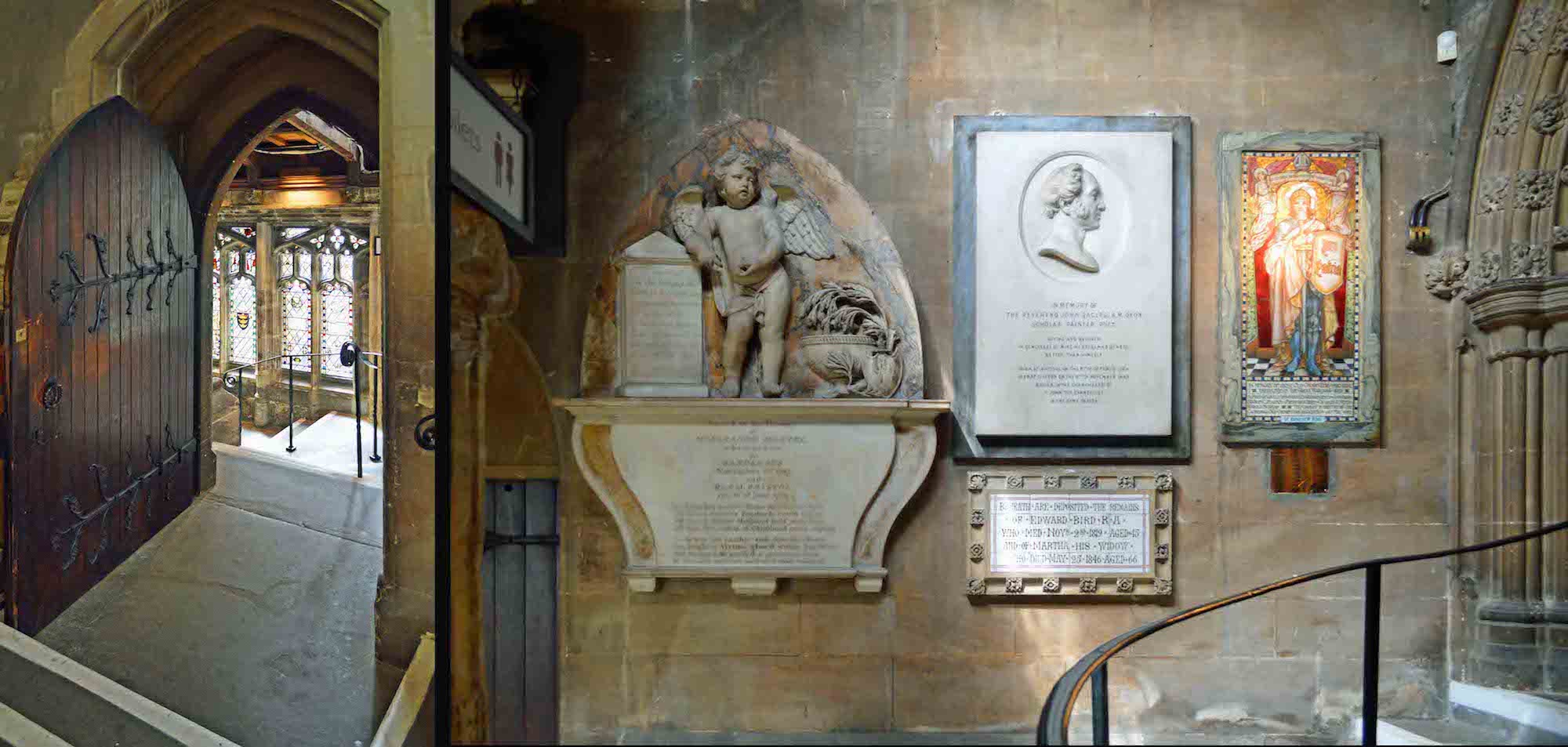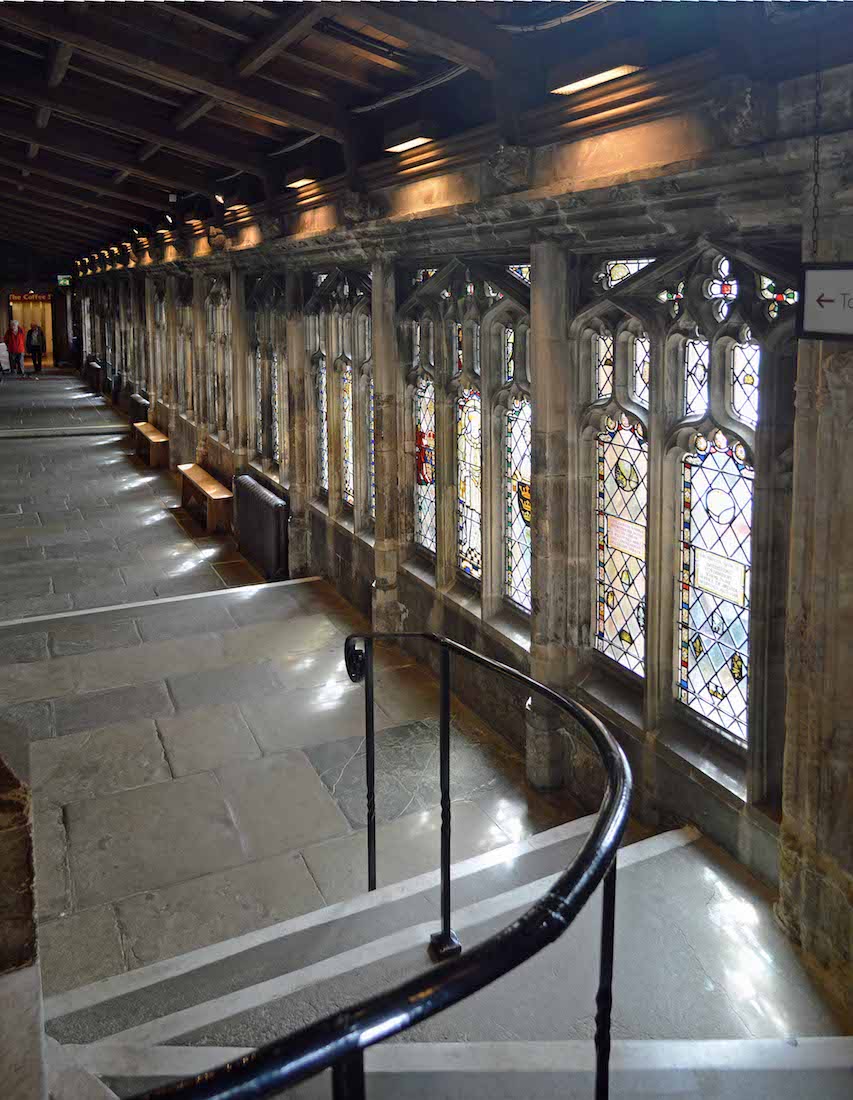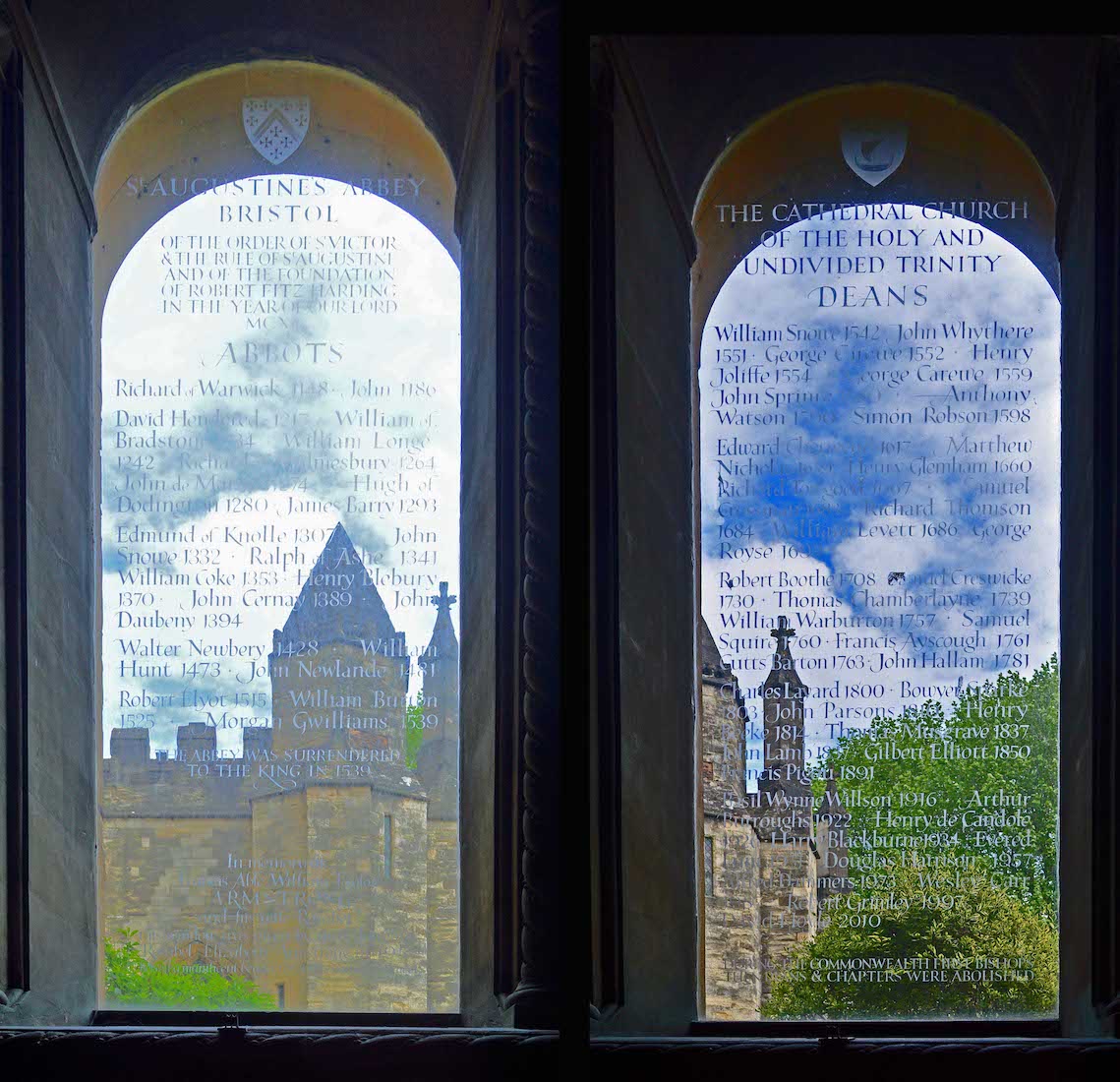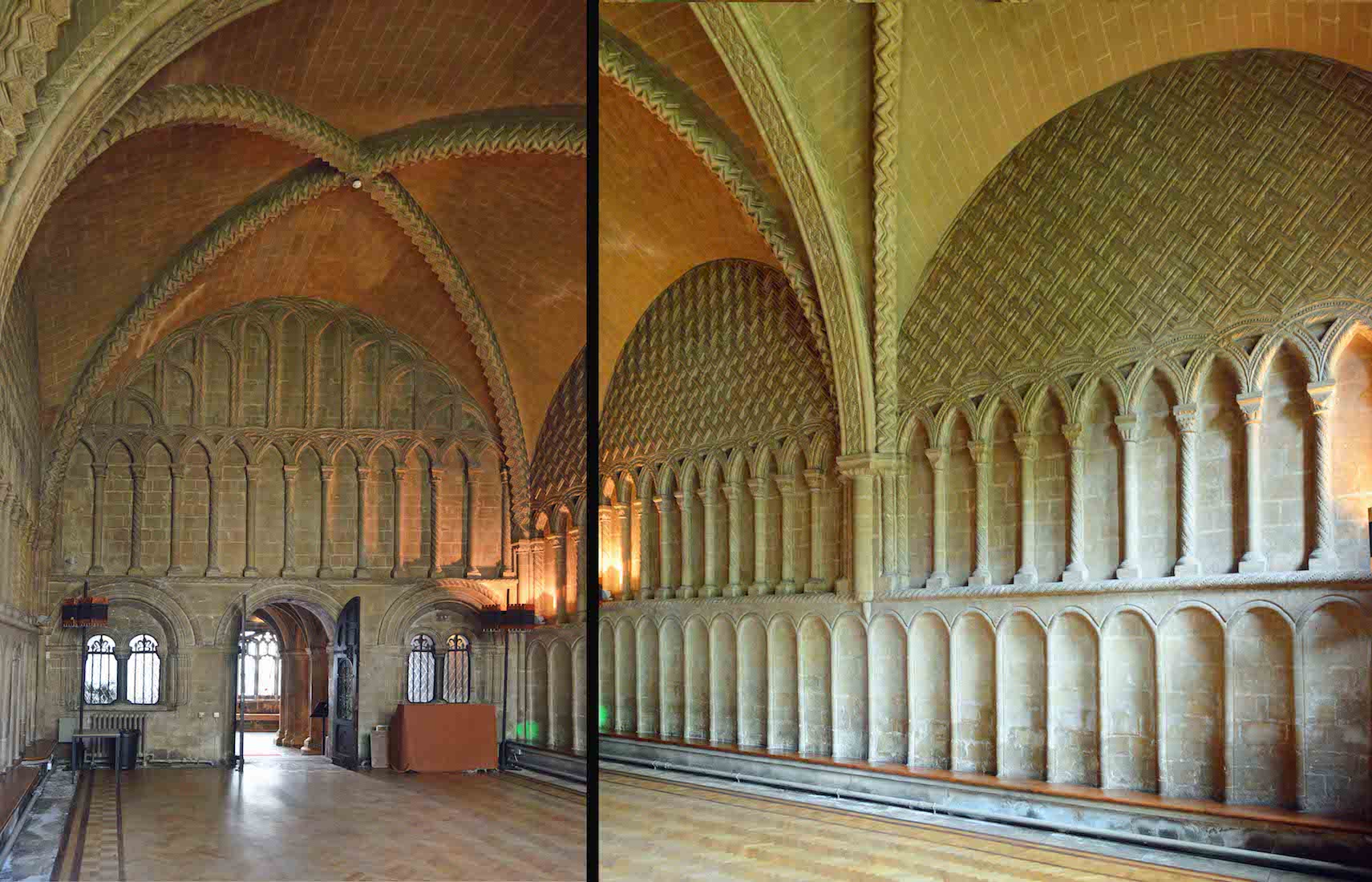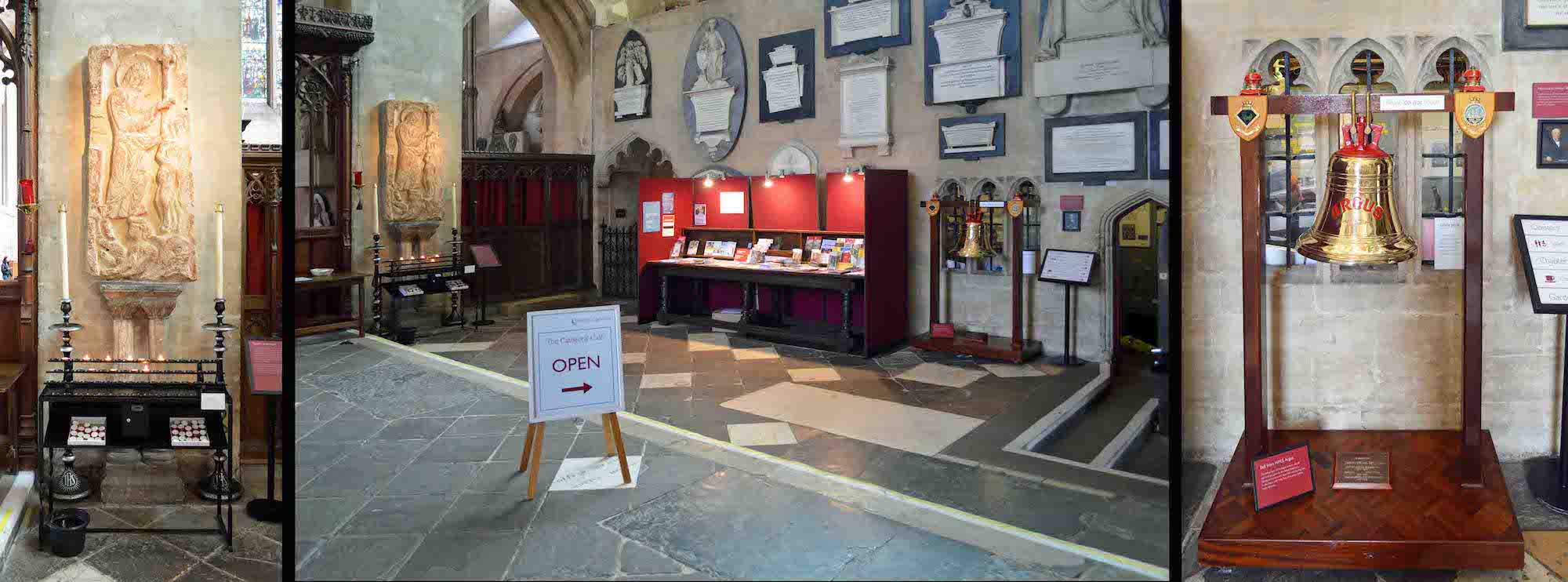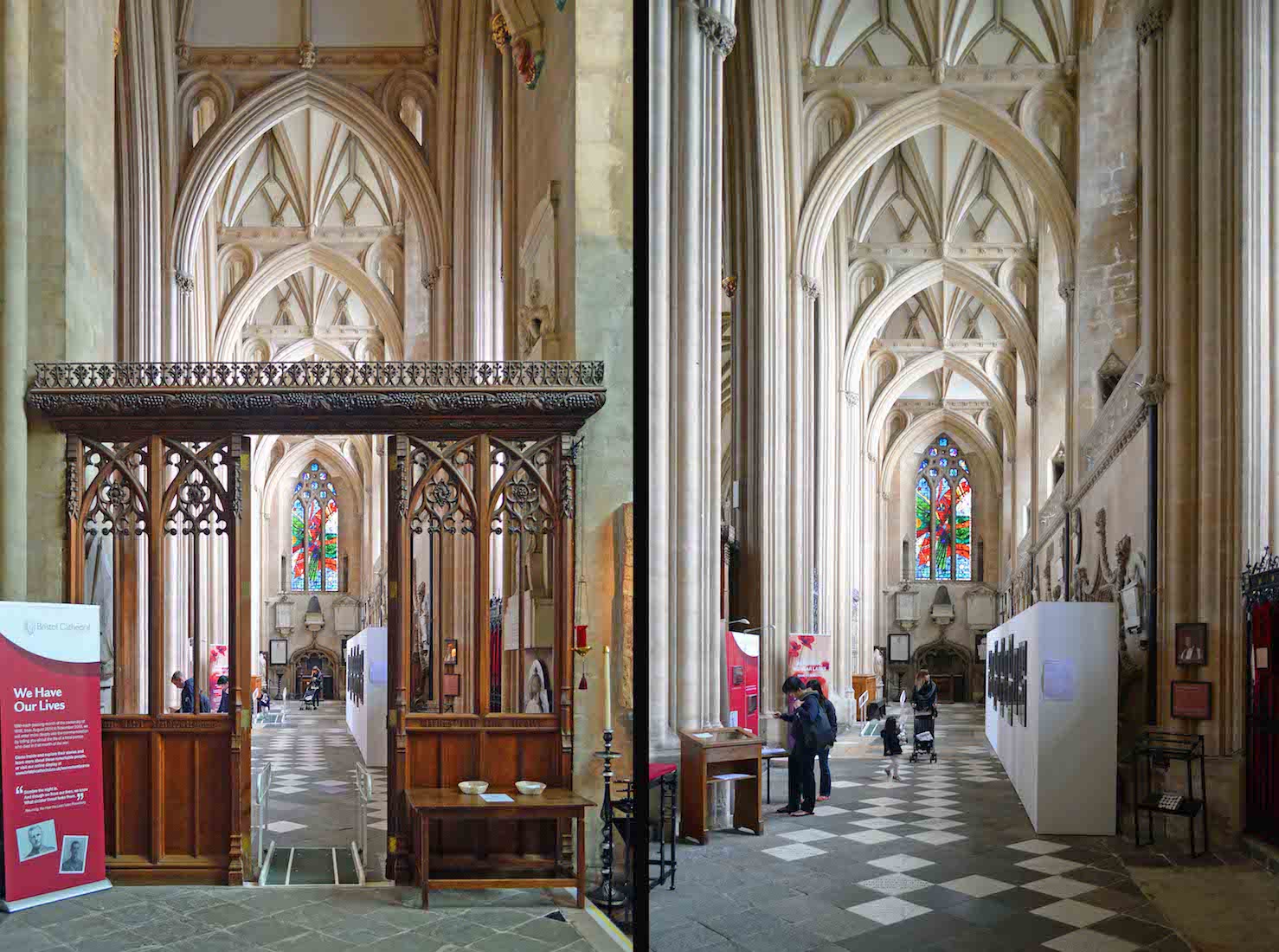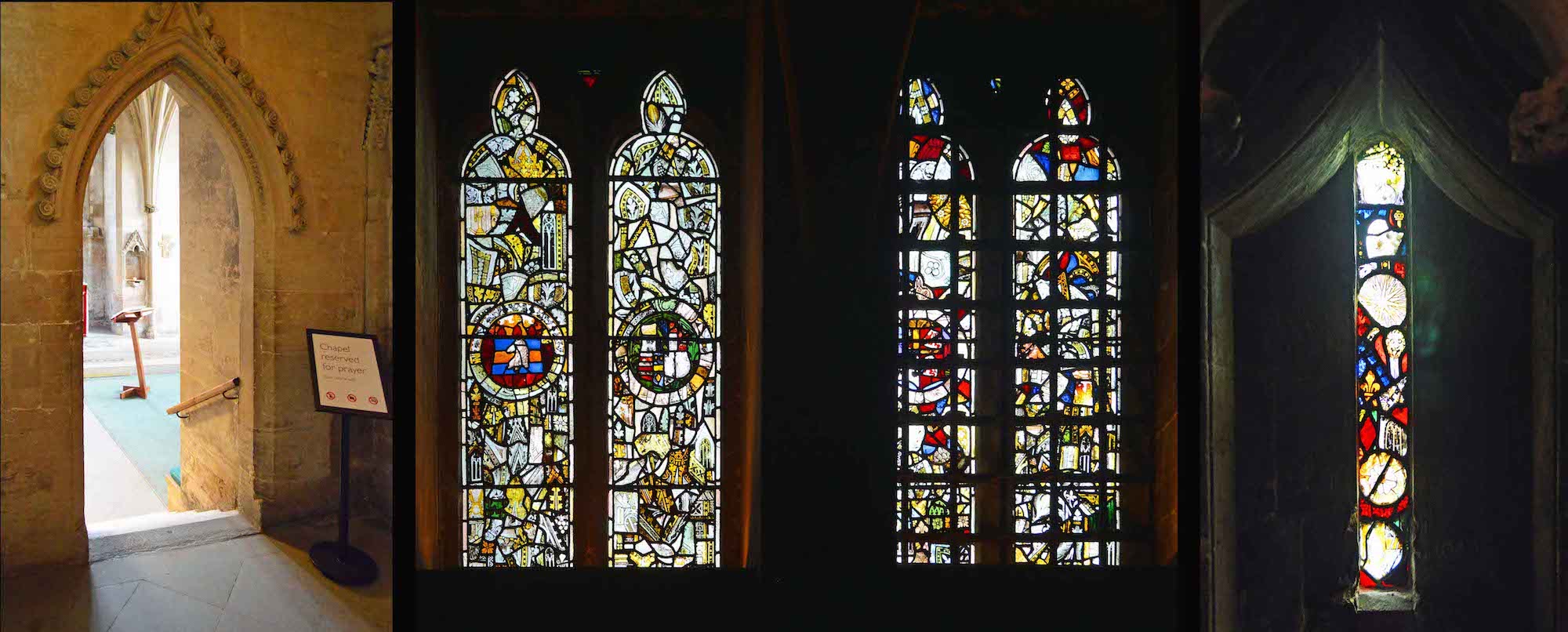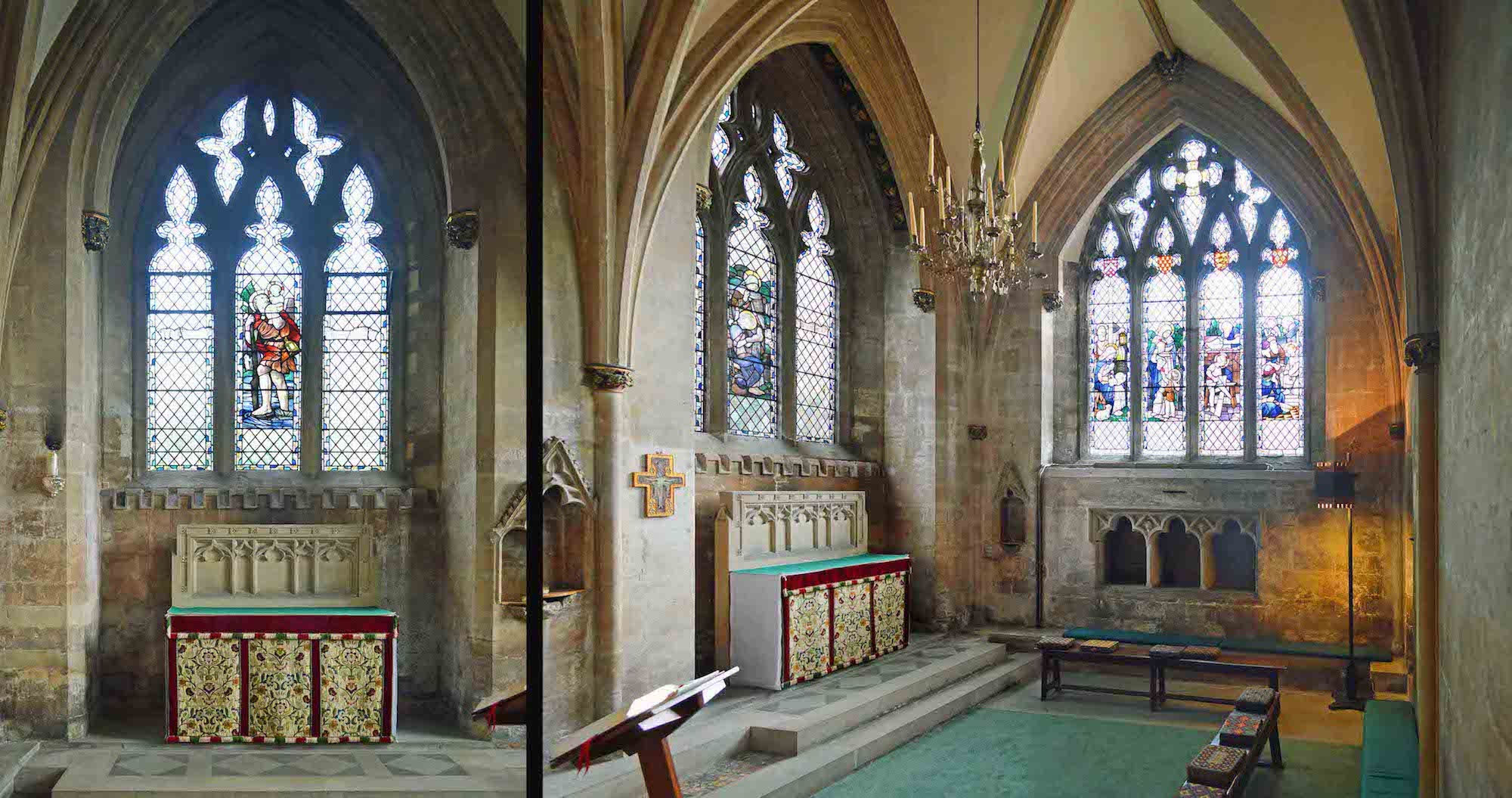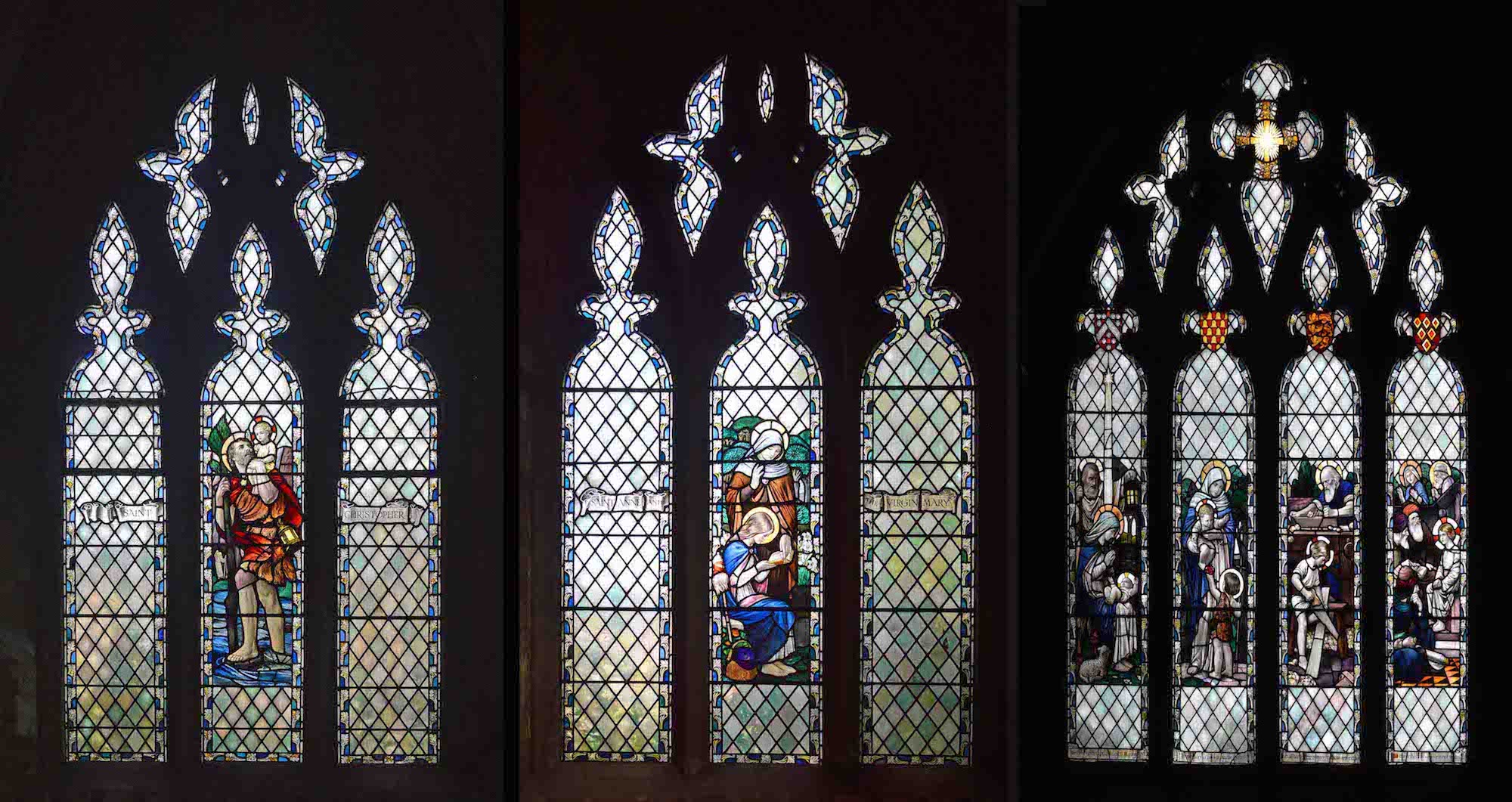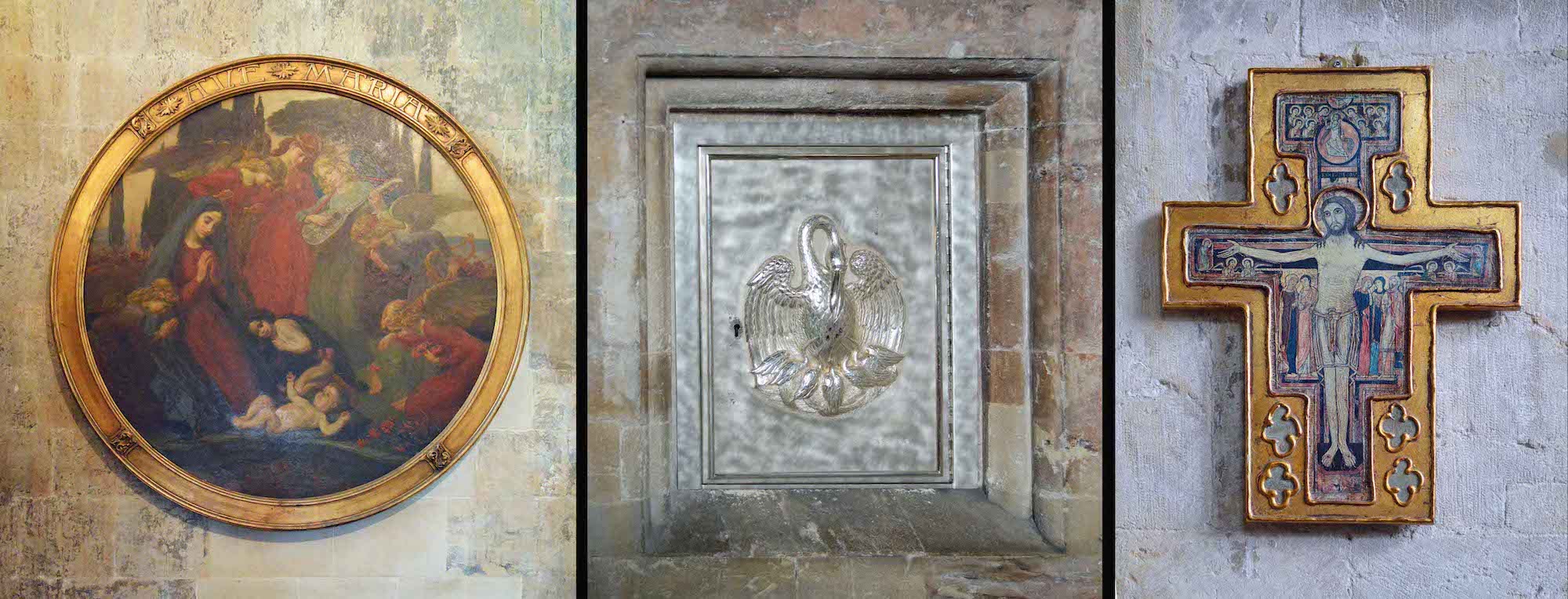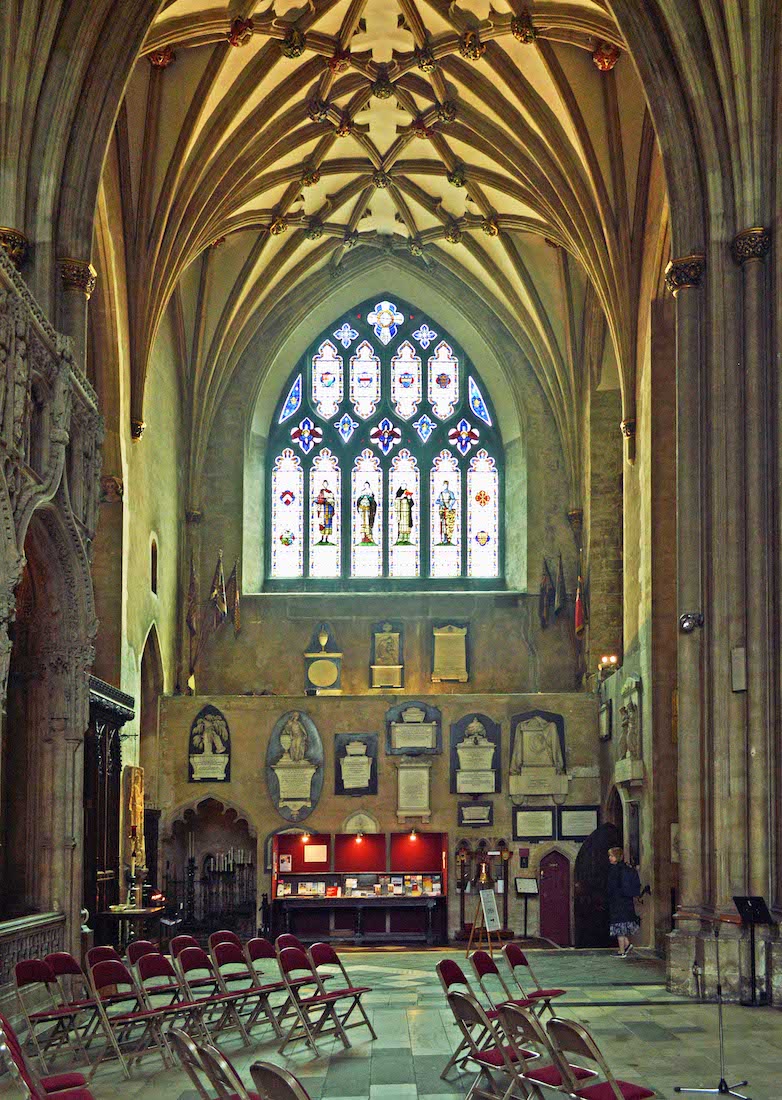
We leave the Elder Lady Chapel, and move across past the nave altar to the South transept. On our approach we are aware of the many plaques on the wall below the large window, and the flags on either side. The open door at bottom right leads to the cloisters (and the café!). This vaulting too has the more complex Lierne style. PLAN
42. SOUTH TRANSEPT DETAIL
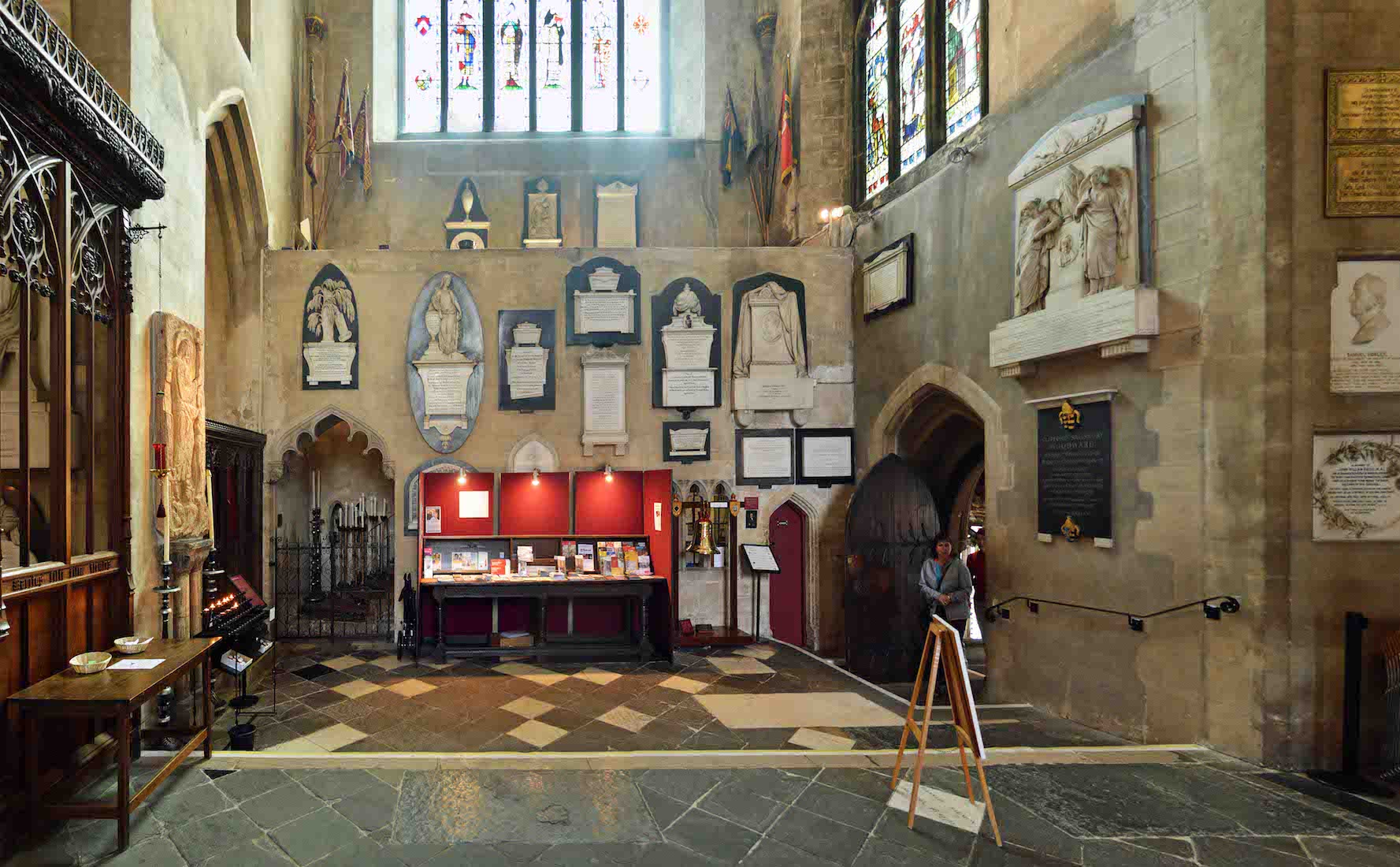
Against the South wall is a display of various Cathedral pamphlets. To its right is a ship’s bell. To its left is a curious niche full of candlesticks! In fact these are well-worn stairs – one of the few areas that remain from the original abbey. They were used by the monks when they came down to pray the night-time services. To the left of this is an arch with a grill, and even closer, an old carved stone. We shall investigate these later. Notice that as well as the large South window, there is also an interesting smaller West window at right.
43. SOUTH TRANSEPT WINDOWS
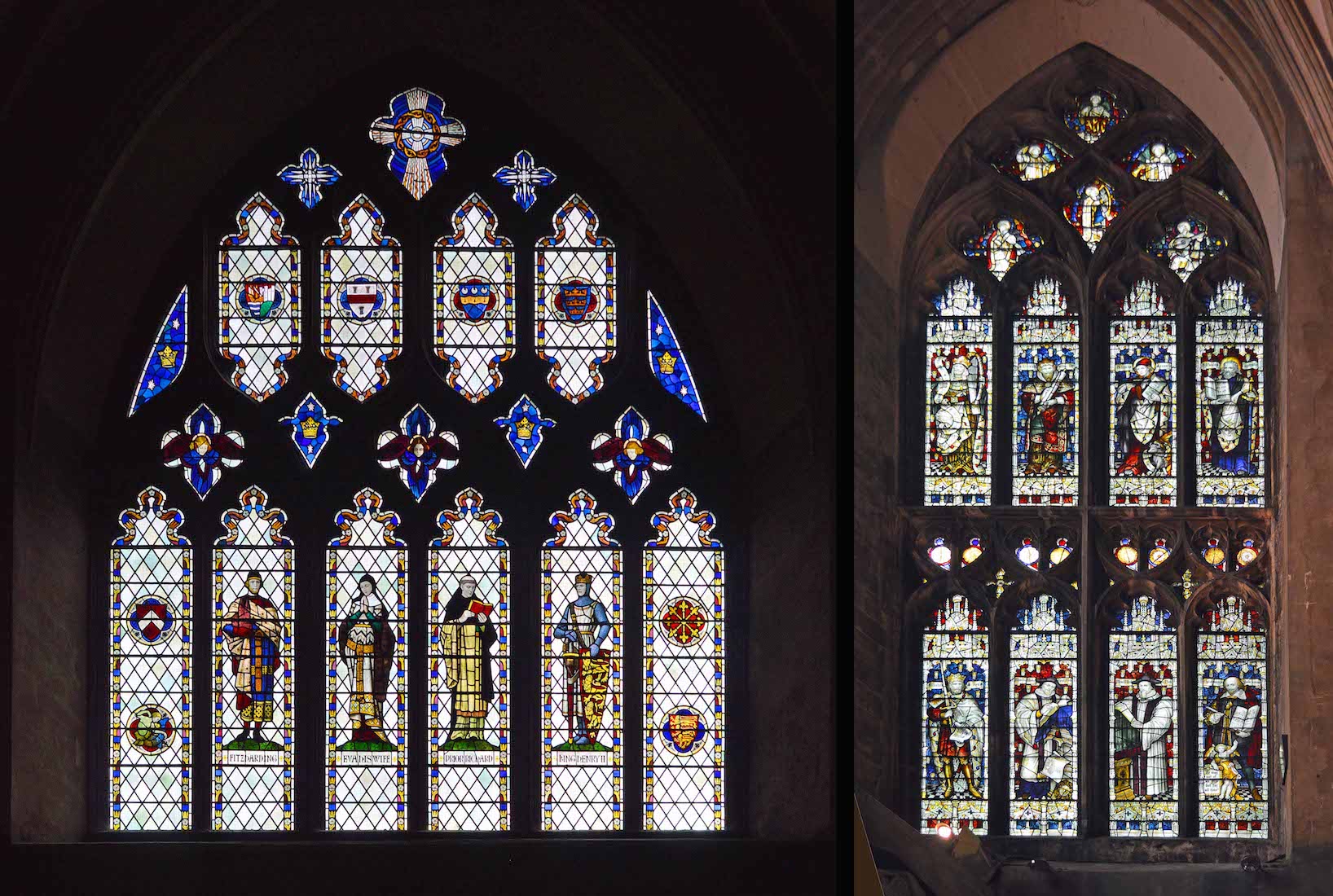
There are four figures featured in the large South window. From left to right, these are: • Fitzharding (Robert Fitzharding 1095–1170 was an Anglo Saxon nobleman who founded St Augustine’s Abbey); • Eva his wife; • Prior Richard; • King Henry II. The figures in the smaller West window include King David(?), St Paul, King Alfred, Richard Hook and William Shakespeare.
44. DOWN TO THE CLOISTER
Leaving the South transept by the door at the right, we descend a few steps to the cloister. On the stair wall are several plaques remembering Eleanor Daniel, Rev John Eccles, Edward and Martha Bird. The colourful memorial is for the Old Choristers who gave their lives in the Great War 1914–1919.
45. EAST CLOISTER
On a sunny afternoon, the East cloister is a blaze of colour, with sunlight streaming through the window wall. This passage is all that remains of the original cloister. The windows contain fragments of windows from elsewhere in the Cathedral that have been long lost as well as newer pieces created by Arnold Robinson in 1953 to show the history of the Cathedral. It is hard to picture the ugly car park on the other side!
46. EAST CLOISTER WINDOWS (SOUTH)
We examine the windows, beginning from the South end. The pattern is for each window to have three lights, with a central figure. Pictured are: Saint Victor (Maurus) (d AD 304); St Augustine (of Hippo) (d. AD 430); [Exit Door]; Robert Fitzharding (d 1170); Henry II (d 1189).
47. EAST CLOISTER WINDOWS (CENTRAL)
In this group of windows, three abbots of the Augustinian Abbey are featured. From left they are Abbot John (d AD 1215), Abbot Knowle (d AD 1330 : window date), Abbot Newbury (d AD 1473). Little is known of Abbot John. Abbot Edward Knowle (served 1306 – 1332) was involved with a major rebuilding of the church. Abbot Walter Newbury (1428 – 1473) was deposed in 1451 and restored in 1456. There must be a story here!
48. EAST CLOISTER WINDOWS (NORTH)
. 
In this grouping are from left: Abbot Newland (d AD 1515), Abbot Elyot (d AD 1526), Henry VIII (d AD 1547). John Newland (1481 – 1515) began rebuilding the church nave. Robert Elyot served from 1515 to 1526. Henry VIII (1491 – 1547; King 1509 – 1547) disagreed with the Pope about having his first marriage to Catherine of Aragon annulled. This led Henry to initiate the English Reformation, separating the Church of England from papal authority and appointing himself the Supreme Head of the Church of England.
50. CHAPTER HOUSE WINDOWS
These etched windows contain commemorative lists of the abbots of the original monastery and the deans of the Cathedral. The earliest abbot was Richard of Warwick, appointed in 1148.
51. INSIDE THE CHAPTER HOUSE
This Chapter House is a hidden gem, and one of the finest examples of Norman architecture in the world. It is distinctive because of the richly carved patterns that cover the arches and vaulting - the designs include geometric patterns and flower details. Notice the stalls around the walls for seating.
52. SOUTH TRANSEPT
We arrived at the Cloisters and Chapter House through the South transept, and we return the same way. We notice now the stone portrayal of the Harrowing of Hell – one of the finest examples of Anglo-Saxon stonework in existence. It dates from just before the Norman Conquest, and was discovered under the Chapter House floor after the fire of 1831. The bell is from the HMS Argus – a British aircraft carrier that served in the Royal Navy from 1918 to 1944.
53. NEWTON CHAPEL
Next to the Harrowing stone is a grill barring entry to the Newton Chapel, which is between the Chapter House and South choir aisle. Apparently this contains large dresser tombs of Henry Newton (d 1599) and Sir Charles Vaughan (1630) and a recumbent effigy of Sir John Newton (d 1661). On the South grill is an interesting charred cross of Bangladesh. One window shows various worthy bishops, and the other a set of coats of arms.
54. SOUTH CHOIR AISLE
We now leave the South transept and enter the South choir aisle. Ahead is a colourful window, on the wall at left are many plaques, unfortunately obscured by a display, and above us are graceful pointed supporting arches.
55. SCREEN THROUGH TO CHOIR, HIGH ALTAR
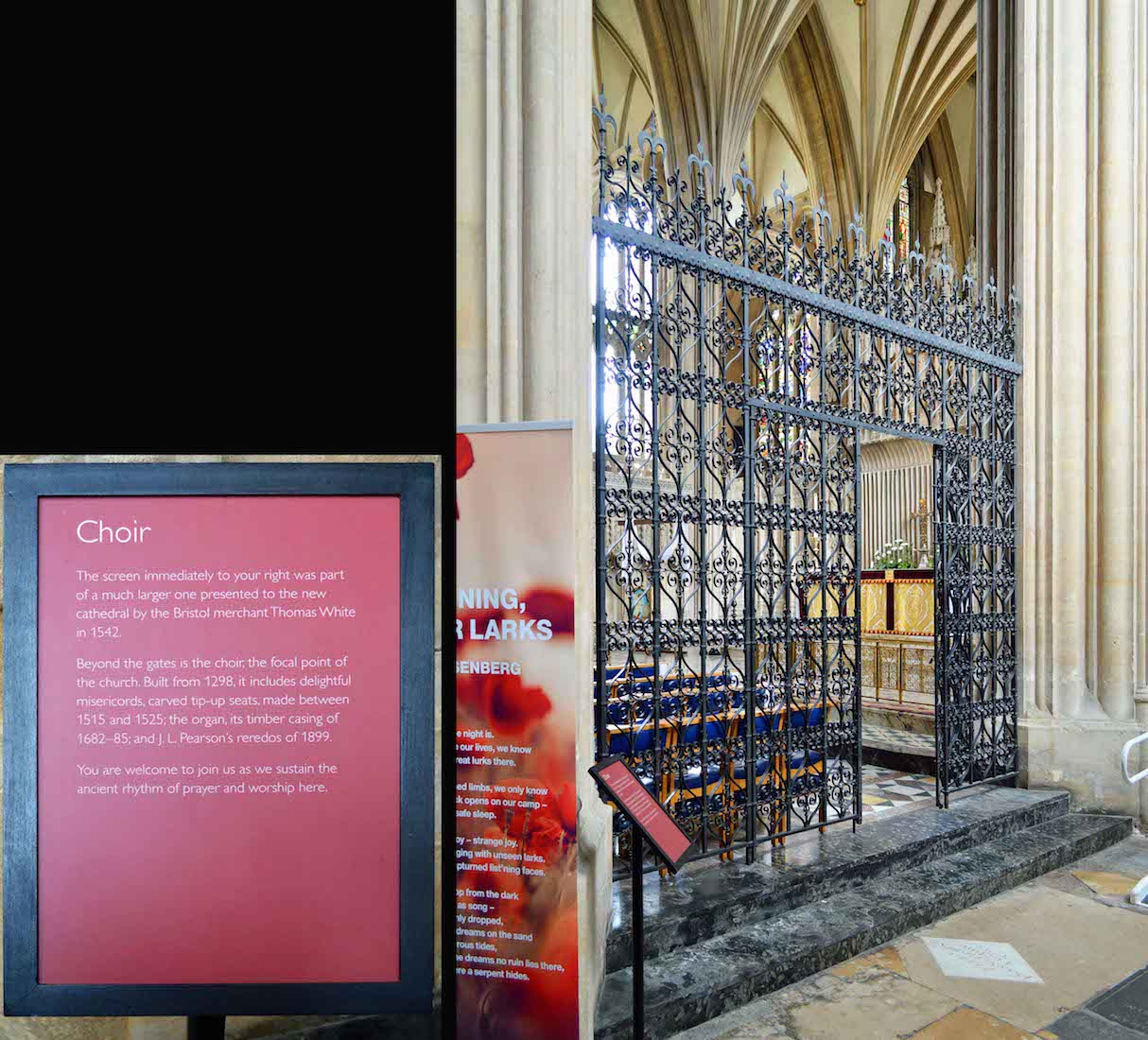
As we approach the East end of the South choir aisle, we come to a doorway to our left. We shall find this leads through to the Berkeley Chapel and its ante-room. There are many memorial plaques on the walls here, and my eyes are drawn to that elevated walkway! More importantly, we have a glimpse of a stained glass window just to the right of the East window.
56. EAST END OF THE SOUTH CHOIR AISLE
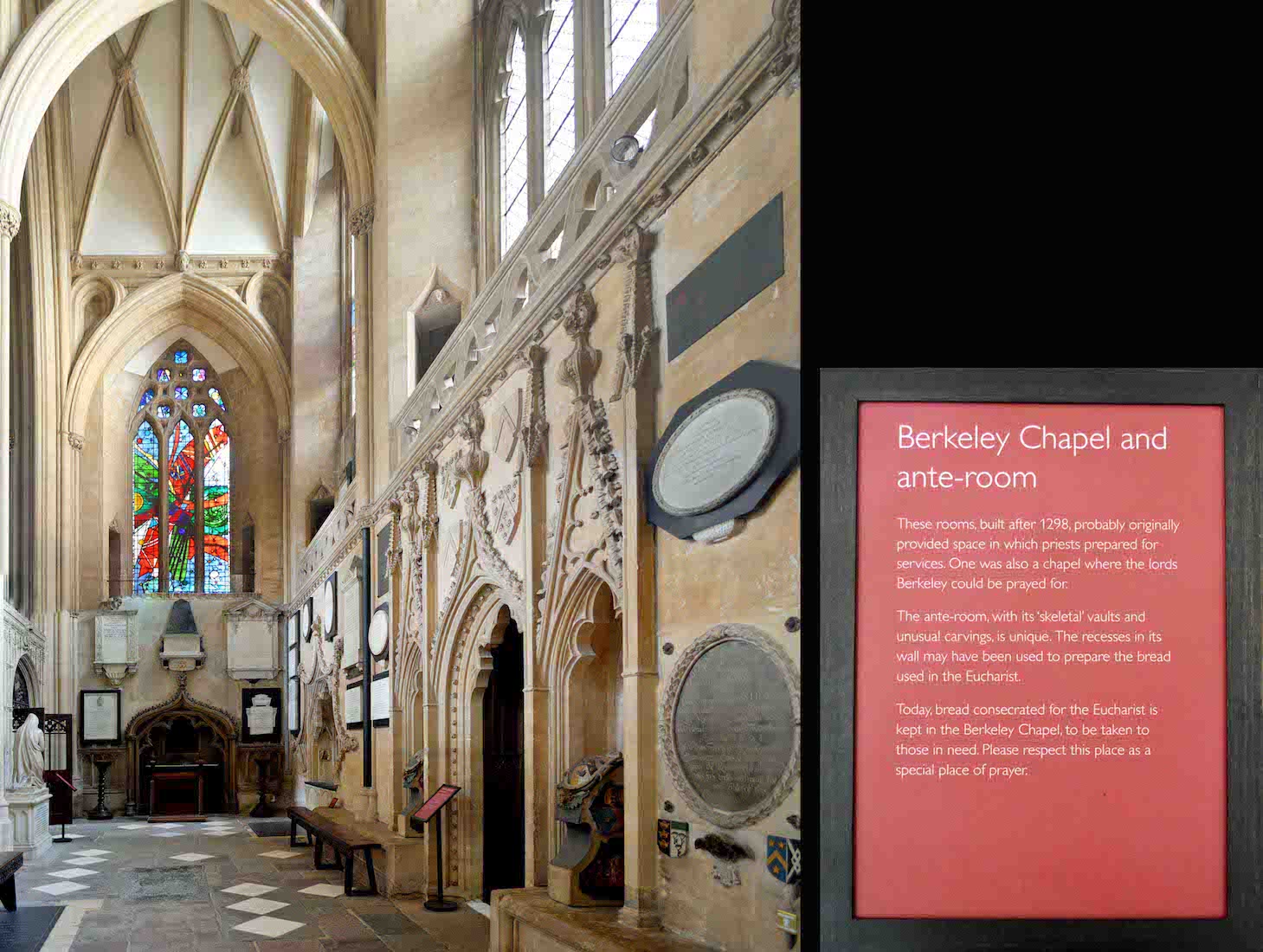
As we approach the East end of the South choir aisle, we come to a doorway to our left. We shall find this leads through to the Berkeley Chapel and its ante-room. There are many memorial plaques on the walls here, and my eyes are drawn to that elevated walkway! More importantly, we have a glimpse of a stained glass window just to the right of the East window.
57. WINDOWS OF THE ANTE-ROOM
The ante-room is a curious little sacristy with steps leading down to the main chapel. In the Middle Ages this area would have been where the sacraments were prepared before the service. It is an extraordinary space, packed with unusual details, from the ‘skeletal’ vault ceiling, the windows of fragmented medieval glass, and the beautiful stone carvings of ammonites and snails (not photographed!) at the inner entrance to the chapel.
58. BERKELEY CHAPEL
This chapel was originally a vestry and place of prayer for the souls of the Berkeley family. (Robert Fitzharding was granted the feudal barony of Berkeley.) The medieval candelabrum was lent to the Cathedral after the Temple Church, where it originally hung, was gutted by fire. It is one of only fifteen of this date and design. The chapel has two identical altars placed against the East wall.
59. BERKELEY CHAPEL WINDOWS
There are three attractive windows in the Berkeley Chapel. At left is a picture of St Christopher carrying the Christ-child across a river – an old legend. At centre we see St Anne teaching her daughter Mary to read. Mary has taken a break from the housework! At right are four scenes from the early life of Christ: the Nativity, Jesus meeting his cousin John, Jesus in the carpenter shop, and Jesus teaching in the Temple.
60. BERKELEY CHAPEL ITEMS
These three items are found on the walls of the Berkeley Chapel. At left is a roundel with a painted scene of the Nativity. At centre is an aumbry with a pelican feeding her chicks. The story is that in time of need the pelican mother draws blood from her breast to feed her chicks. The aumbry is used to store the reserved Elements of the Eucharist. At right is an old crucifix with a painting of Christ on the Cross.


